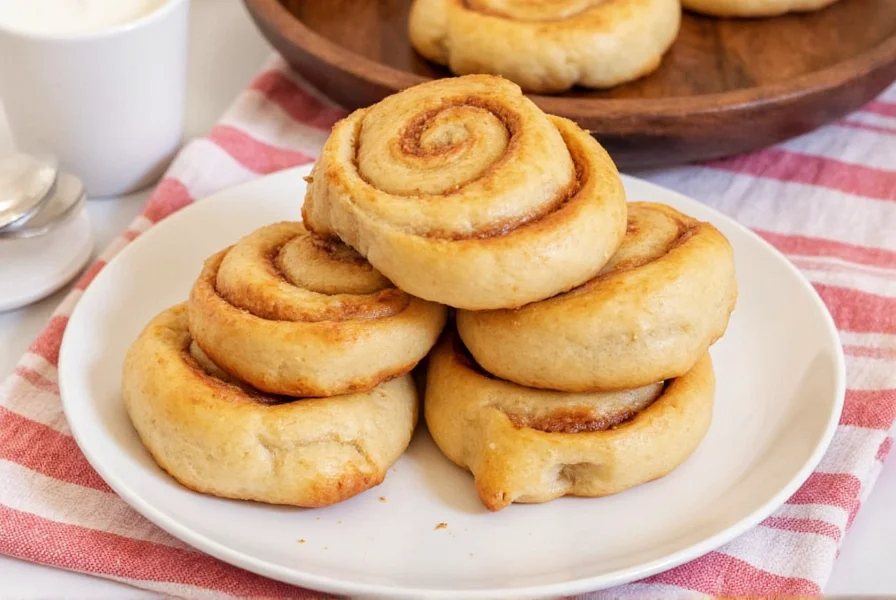These shelf-stable convenience products have become pantry staples for home bakers seeking quick breakfast solutions or dessert options. Understanding how to maximize their potential transforms basic store-bought items into bakery-quality treats with minimal effort.
The Science Behind Canned Cinnamon Rolls
Canned cinnamon rolls work through a clever combination of refrigeration and controlled yeast activation. The dough contains specially formulated yeast that remains dormant during refrigeration but activates when exposed to room temperature. This "time-release" yeast technology allows manufacturers to create products with extended shelf life while maintaining rising capability.
When you open the can, the pressure release causes the dough to expand slightly, initiating the rising process. The filling typically contains cinnamon, sugar, and often brown sugar or other flavor enhancers that melt during baking, creating that signature gooey center.

Perfect Baking Technique for Optimal Results
While package instructions provide basic guidance, achieving truly exceptional results requires understanding the nuances of baking canned cinnamon rolls. Temperature control proves critical—allowing the rolls to sit at room temperature for 15-20 minutes before baking yields better rise and texture than placing them directly in the oven.
The ideal baking temperature ranges between 350-375°F (175-190°C), depending on your oven's calibration. Most standard 5-ounce rolls require 15-22 minutes, but checking at the 12-minute mark prevents overbaking. The rolls should develop a golden-brown exterior while maintaining a soft, pillowy interior.
Five Professional-Grade Enhancements
Transform your store-bought cinnamon rolls with these chef-approved techniques that require minimal additional ingredients:
- Butter boost—Place small pats of butter between the rolls before baking for richer flavor and improved moisture retention
- Temperature trick—Let rolls rise on the stovetop while preheating the oven to optimize yeast activity
- Filling infusion—Sprinkle additional cinnamon-sugar mixture between the layers after separating the rolls
- Icing upgrade—Mix the included icing with cream cheese or a splash of vanilla for enhanced flavor complexity
- Texture transformation—Brush with melted butter immediately after baking for a professional bakery finish
Brand Comparison: Key Characteristics
| Brand | Rise Time | Filling Quality | Icing Type | Special Features |
|---|---|---|---|---|
| Pillsbury | 15-20 min | Classic cinnamon-sugar | Creamy glaze | Most consistent rise |
| Imperial | 12-15 min | Richer brown sugar | Thicker frosting | Better for reheating |
| Great Value | 18-22 min | Simpler cinnamon blend | Standard icing | Most economical option |
Creative Applications Beyond Basic Baking
Canned cinnamon roll dough offers remarkable versatility beyond traditional baking. Try these innovative approaches:
- Cinnamon roll pull-apart bread—Cut rolls into quarters and arrange in a bundt pan for dramatic presentation
- Dessert pizza—Flatten dough pieces and top with fruit and cream cheese for quick dessert
- Breakfast sandwiches—Wrap cooked rolls around sausage patties for portable morning meals
- Cinnamon roll muffins—Press dough pieces into muffin tins with fruit fillings
- Ice cream topping—Warm individual rolls and serve over premium ice cream
Troubleshooting Common Issues
Even with convenience products, problems can occur. Here's how to address frequent challenges when working with canned cinnamon rolls:
Dense or heavy rolls: This typically indicates insufficient rising time. Allow rolls to sit at room temperature for 15-20 minutes before baking. Cold kitchen environments particularly affect rise quality.
Burnt bottoms: Place a baking sheet on the rack below to shield from direct heat. Alternatively, reduce oven temperature by 25°F and extend baking time slightly.
Dry texture: Overbaking remains the primary culprit. Set timer for 2-3 minutes less than package instructions suggest and check for doneness.

Storage and Reheating Best Practices
Proper storage maintains quality for future enjoyment. Cool completely before storing in airtight containers at room temperature for up to 3 days. For longer preservation, freeze individual rolls on a baking sheet before transferring to freezer bags.
Reheating requires careful technique—microwave reheating often creates uneven results. Instead, place rolls on a baking sheet in a 300°F oven for 5-8 minutes, covering loosely with foil if the top begins browning too quickly. For single servings, a toaster oven preserves texture better than microwave methods.
Frequently Asked Questions
Can you bake canned cinnamon rolls without the provided icing?
Yes, you can bake canned cinnamon rolls without the included icing. Many bakers prefer alternative toppings like cream cheese glaze, caramel sauce, or simply dusting with powdered sugar. The icing primarily serves as a finishing touch and doesn't affect the baking process itself.
How do you make canned cinnamon rolls rise faster?
To accelerate rising, place the separated rolls in a slightly warm environment (85-90°F). Positioning them near a warm oven or in a microwave with a cup of hot water creates ideal conditions. Avoid temperatures exceeding 95°F, which can kill the yeast and prevent proper rising.
Why do my canned cinnamon rolls sometimes collapse after baking?
Collapse typically occurs from premature removal from the oven or sudden temperature changes. Allow rolls to bake until fully set—when they spring back lightly when touched. Avoid opening the oven door during the first two-thirds of baking time to prevent temperature fluctuations that cause collapse.
Can you refrigerate unbaked canned cinnamon rolls overnight?
Yes, you can refrigerate unbaked rolls overnight. Place them in the baking pan, cover tightly with plastic wrap, and refrigerate. The next morning, allow 20-30 minutes at room temperature before baking. This slow rise often enhances flavor development while providing morning convenience.
What's the best way to store leftover canned cinnamon rolls?
Store cooled rolls in an airtight container at room temperature for up to 3 days. For longer storage, freeze individual rolls on a baking sheet before transferring to freezer bags. When reheating, the oven or toaster oven preserves texture better than microwave methods, which often create uneven results.











 浙公网安备
33010002000092号
浙公网安备
33010002000092号 浙B2-20120091-4
浙B2-20120091-4